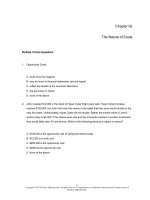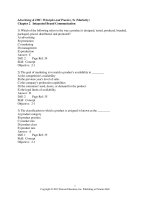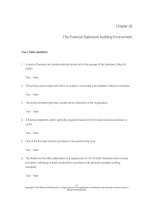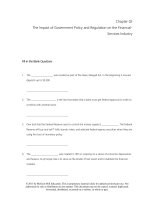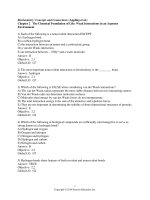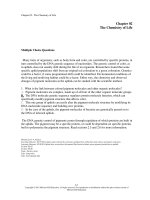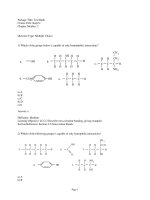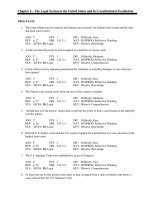Psychology concepts and connections 9th edition rathus test bank
Bạn đang xem bản rút gọn của tài liệu. Xem và tải ngay bản đầy đủ của tài liệu tại đây (108.69 KB, 70 trang )
Chapter 1 Part A--What Is Psychology?
Student: ___________________________________________________________________________
1.
Psychology is defined as the scientific study of
A. behavior and mental processes.
B. diagnosis and treatment of behavioral disorders.
C. conscious and unconscious mental processes.
D. the mind.
2.
The scientific study of behavior and mental processes describes
A. behaviorism.
B. psychoanalysis.
C. psychology.
D. clinical psychology.
3.
Eduardo DeLeon is engaged in scientific research involving the study of behavior and mental processes.
DeLeon is a
A. psychotherapist.
B. psychoanalyst.
C. psychiatrist.
D. psychologist.
4.
When a psychologist tells a client to use mental imagery in an attempt to help the person cope with a
problem, she is attempting to reach which goal of psychology?
A. describe
B. explain
C. predict
D. control
5.
A satisfactory theory of alcohol addiction should allow us to predict
A. the types of individuals who are at risk for developing this problem.
B. what type of intervention is successful for recovery.
C. both a and b.
D. none of the above.
6.
An educational psychologist who advises teachers on how to establish classroom discipline is applying
which of the following goals of psychology?
A. prediction
B. control
C. explanation
D. description
7.
An unsatisfactory psychological theory of thirst would not
A. be able to predict when people will or will not drink.
B. be able to describe age-related drinking behavior.
C. both a and b.
D. none of the above.
1
8.
A conception of apparent relationships among observed events defines
A. science.
B. theory.
C. prediction.
D. the school of psychology.
9.
When a psychologist forms conclusions regarding a client's chance of recovery, he is attempting to reach
which goal of psychology?
A. description
B. explanation
C. prediction
D. control
10. Which of the following is the best definition of psychology?
A. The study of human behavior.
B. The scientific study of behavior and mental processes.
C. The study of why people behave in abnormal and unique ways.
D. The study of how the mind works.
11. Mary is crying in her teacher's office. Which goal of psychology does this represent?
A. describe
B. explain
C. predict
D. control
12. Braden's score on his SAT suggests he will do very well in an advanced English class. Which goal of
psychology does this example represent?
A. describe
B. explain
C. predict
D. control
13. Psychologists often help judges and juries decide whether a criminal in jail will commit another crime if
released. Which goal of psychology does that example represent?
A. explain
B. describe
C. predict
D. control
14. Dr. Jones is interested in determining the effects of marijuana on learning in a classroom setting. This
type of research is:
A. pure.
B. applied.
C. natural.
D. situational.
2
15. ____ research has no immediate application to personal or social problems and has been characterized as
research for its own sake.
A. Pure
B. Applied
C. Conceptual
D. Observational
16. Research examining how the nervous system works conducted for no other reason than to determine
"how it works" would be considered ____ research.
A. applied
B. pure
C. experimental
D. explanatory
17. Dr. Garces is interested in assessing the driving reaction times of the elderly for the purpose of driving
improvement classes. She is doing what type of research?
A. clinical
B. pure
C. applied
D. naturalistic
18. Psychologists seek to formulate principles of human behavior through research such as
A. studies of memory disorders.
B. surveys and experiments.
C. introspection.
D. insight.
19. Which of the following is not true of psychological theories?
A. Theories make assumptions about behavior.
B. Theories explain behavior and mental processes.
C. Predictions are derived from theories.
D. Theories are always discarded as new observations are made.
20. The clinical psychologist's aim in applying prediction and control principles to a client's behavior is to
A. decide the treatment.
B. help the client meet his or her goals in treatment.
C. allow the client a narrow range of options for his or her behavior.
D. use a database to formulate a treatment for the client.
21. Dr. Rossini is developing a training program to help a young woman with mental retardation to sort
clothes in the laundry of the residential facility in which she lives. Whenever she performs her job
according to the protocol, she receives a reward. If she does not stay on task, she receives no reward.
Applying the principles of learning theory to the direct modification of human conduct is referred to as
A. pure research.
B. basic research.
C. psychoanalysis.
D. the practice of psychology.
3
22. The results of ____ research in the study of the perceptual development of infants and lower animals is
often useful in formulating the treatment of visual disorders in humans.
A. pure
B. basic
C. controlled
D. action
23. Applied research is research undertaken
A. with humans.
B. with lower animals.
C. for its own sake.
D. to find solutions to specific problems.
24. The difference between pure and applied research is the difference between
A. prediction and control.
B. practice and theory.
C. research for its own sake and research to solve specific problems.
D. application and explanation.
25. Research using computers to understand artificial intelligence is considered ____ research.
A. pure
B. applied
C. longitudinal
D. none of the above
26. Dr. Langer is treating a college student for depression in his private practice. Most likely Dr. Langer is
a(n) ____ psychologist.
A. counseling
B. school
C. educational
D. clinical
27. Jean, a divorced mother with two children, married Harry, a widower with a teenage daughter. From the
onset of her relationship with Harry, Jean had difficulty in relating to the daughter. Once married, the
family problems between stepmother and stepdaughter became exacerbated. Who might be consulted?
A. a developmental psychologist
B. an educational psychologist
C. a counseling psychologist
D. a psychiatric social worker
28. Diagnosing the severity of mental illness and behavior problems is usually the job of a(n) ____
psychologist.
A. clinical
B. counseling
C. school
D. educational
4
29. School psychologists are employed by school districts to
A. develop achievement and aptitude tests.
B. identify and assist students who have problems that interfere with their learning.
C. assess the development of children in the school system.
D. develop instructional methods for teachers to employ.
30. Interpretation of a client's symptoms is to a clinical psychologist as the development of an achievement
test is to a(n) ____ psychologist.
A. social
B. developmental
C. educational
D. personality
31. Dr. Kendall is interested in the effects of teacher style (warm and supportive versus formal and
objective) on the learning of mathematics by sixth graders. Most likely, Dr. Kendall is a(n) ____
psychologist.
A. educational
B. personality
C. school
D. experimental
32. ____ psychologists study the relationship between genetic and environmental factors on growth of the
individual through the life span.
A. Biocultural
B. Personality
C. Developmental
D. Social
33. The study of human traits and characteristics is of interest to ____ psychologists.
A. clinical
B. personality
C. community
D. social
34. ____ psychologists are concerned with racism, sexism, and ageism.
A. Community
B. Personality
C. Forensic
D. Social
35. A theory that divides human behavior into two basic traits, introversion and extraversion, was probably
formulated by a ____ psychologist.
A. developmental
B. personality
C. behavioral
D. clinical
5
36. How the individual is affected by the group and the effects of the individual on the group are the
concerns of ____ psychologists.
A. clinical
B. sociological
C. community
D. social
37. Which of the following psychologists is most likely to conduct pure research?
A. experimental
B. organizational
C. consumer
D. human factors
38. The design of the instrument layout of a new helicopter was carried out by industrial engineers in
consultation with ____ psychologists.
A. consumer
B. experimental
C. industrial
D. human factors
39. Dr. Wang has just prescribed antidepressants for her patient. She must be a:
A. clinical psychologist.
B. social psychologist.
C. marital counselor.
D. psychiatrist.
40. The following psychologists have clients with adjustment problems but not serious psychological
disorders.
A. clinical psychologists
B. counseling psychologists
C. educational psychologists
D. developmental psychologists
41. Dr. Correia is working with schizophrenics in a hospital setting. What type of psychologist is Dr.
Correia?
A. clinical psychologist
B. counseling psychologist
C. educational psychologist
D. developmental psychologist
42. Which of the following is a difference between a psychologist and a psychiatrist?
A. Seeing people who have psychological problems.
B. Working in a hospital.
C. Having an MD.
D. Doing research on psychological therapies.
6
43. A main difference between educational psychologists and school psychologists is that school
psychologists focus on:
A. course planning.
B. instructional methods.
C. motivation research.
D. problems that interfere with learning.
44. Educational psychologists are most interested in research concerning:
A. personal problems.
B. instructional methods.
C. unconscious behavior.
D. problems that interfere with learning.
45. Worker satisfaction issues would most likely be studied by ____ psychologists.
A. clinical
B. industrial
C. educational
D. health
46. Industrial psychologists are more likely to be involved in research examining which of the following
topics?
A. Designing factory workspace for better worker efficiency.
B. The memory of rats in learning a maze.
C. The effects of growth hormones on infant chimps.
D. Juror selection in cases involving white collar crimes.
47. Dr. Bonds helps people develop better exercise routines, nutritional strategies, and relaxation techniques.
What type of psychologist is Dr. Bonds?
A. educational
B. social
C. organizational
D. health
48. Shopping behavior would be studied by a ____ psychologist.
A. health
B. clinical
C. consumer
D. organizational
49. Dr. Ippolito is interested in child rearing techniques of single parent families. She is most likely a/an
____ psychologist.
A. developmental
B. counseling
C. social
D. health
7
50. Dr. James has just completed a study examining the effects of aggressive television programs on 3-, 4-,
and 5-year-old children. She is most likely a ____ psychologist.
A. developmental
B. counseling
C. social
D. health
51. Dr. Patil studies the development of attitudes among college students. He is a ____ psychologist.
A. developmental
B. counseling
C. social
D. health
52. After an advertising campaign with a catchy jingle failed to generate sales for a new shampoo, the
advertising director hired Faith Broadside to analyze the defective campaign and to propose an
alternative approach. Faith is most likely a(n) ____ psychologist.
A. consumer
B. social
C. organizational
D. human factors
53. As much as she tried to lose weight, Pauline could not achieve her goal of 15% weight loss.
Accordingly, she made an appointment to consult with Dr. Richman, a ____ psychologist.
A. clinical
B. counseling
C. human factors
D. health
54. Club NoFat, a fitness center, introduced a new program that linked diet to the exercise program and was
looking for someone to run the program. The club's director especially wanted to hire someone with a
background in stress management in the control of health problems. Most likely, she was looking for
a(n)
A. personal trainer.
B. sports psychologist.
C. health psychologist.
D. aerobics instructor.
55. The ____ psychologist examines ways in which lifestyle, habits, and attitudes are related to heart
disease, cancer and diabetes.
A. clinical
B. health
C. counseling
D. forensic
56. Yolanda gives a careful description of all of her thoughts, experiences, and emotions after she underwent
a "near-death" experience in which she felt herself leaving her body. The method Yolanda and the
researcher are using is called
A. insight.
B. self-revelation.
C. recovered memory.
D. introspection.
8
57. Wilhelm Wundt founded the school of psychology called
A. functionalism.
B. psychoanalysis.
C. behaviorism.
D. structuralism.
58. Under the school of structuralism, an analytic study of objective sensations and subjective feelings is
accomplished through the method called
A. conditioning.
B. psychoanalysis.
C. introspection.
D. insight.
59. The very first psychological laboratory was established by
A. Wilhelm Wundt.
B. William James.
C. Charles Darwin.
D. Gustav Fechner.
60. What distinguished Wilhelm Wundt's contribution from other contributions to psychology?
A. He wrote the first textbook of psychology.
B. He defined psychology as the science of behavior.
C. He established psychology as a laboratory science.
D. He studied insight in lower animals.
61. Wilhelm Wundt felt that the object of psychology was the study of the mind as a natural event and that
the best way to approach the study of psychology was to
A. break down conscious experience into basic elements.
B. focus on the continuity between conscious experience and behavior.
C. analyze the relation between sensory stimuli and behavior.
D. determine the functions of conscious experience.
62. Structuralism defined experience in terms of
A. behavioral tendencies and habits.
B. the continuity of consciousness and unconscious processes.
C. the functions of consciousness.
D. sensations, feelings, and mental images.
63. The early roots of psychology can be traced to the:
A. Greek philosophers.
B. Roman generals.
C. German scientists.
D. American medical doctors.
64. One of the first recorded books examining the mind was written by the early Greek philosopher:
A. Hippocrates.
B. Aristotle.
C. Oedipus.
D. Plato.
9
65. The main method used in the school of structuralism was:
A. introspection.
B. stream of consciousness.
C. observation.
D. perception.
66. The founder of the American school of psychology known as functionalism was:
A. Wilhelm Wundt.
B. E.B. Titchner.
C. John B. Watson.
D. William James.
67. He was known as the first psychologist and the founder of structuralism.
A. Wilhelm Wundt
B. William James
C. John Watson
D. Aristotle
68. Functionalism was established by
A. G. Stanley Hall.
B. Wilhelm Wundt.
C. John Watson.
D. William James.
69. Which of the following statements is most likely to have been made by a functionalist psychologist?
A. The mind is composed of discrete elements.
B. Perception is greater than the sum of its parts.
C. The only object of psychology is the study of behavior.
D. Adaptation to the environment is the purpose of mental processes and behavior.
70. The school of psychology that emphasizes the purposes of mind and behavior and views consciousness
as a continuous, not discrete, process is called
A. functionalism.
B. behaviorism.
C. structuralism.
D. psychoanalysis.
71. A functionalist would agree with which of the following statements?
A. Consciousness can be broken down into elemental parts.
B. Consciousness is a continuous process.
C. Both a and b.
D. None of the above.
72. Charles Darwin's theory of evolution predicted that organisms that survived and reproduced were ____
than those less fit.
A. more intelligent
B. better adapted to the environment
C. more conscious of their surroundings
D. better at problem solving
10
73. The functionalists expanded the study of psychology to include behavior as well as consciousness and
asked how mental processes and behavior
A. were broken down into sensations, feelings, and thoughts.
B. were part of the unconscious.
C. led the individual to self-knowledge.
D. assisted the organism to adapt to the environment.
74. One similarity between structuralism and functionalism was:
A. unconscious behavior.
B. they both focused on real world situations.
C. introspection.
D. observable behavior.
75. The main method used in the school of behaviorism was:
A. introspection.
B. stream of consciousness.
C. observation.
D. perception.
76. John B. Watson argued for a psychology based on the study of
A. stream of consciousness.
B. unconscious mental processes.
C. measurable behavior.
D. sensation, feelings, and mental images.
77. John B. Watson established ____ as a school of psychology.
A. behaviorism
B. functionalism
C. structuralism
D. psychoanalysis
78. John Watson proposed a definition of psychology that omitted all except
A. mental processes.
B. behavior.
C. consciousness.
D. feelings and thoughts.
79. Which of the following psychologists would have most in common with John B. Watson?
A. B.F. Skinner
B. Sigmund Freud
C. William James
D. Wilhelm Wundt
80. Watson is to behaviorism as Wundt is to ____.
A. introspection
B. structuralism
C. functionalism
D. psychoanalysis
11
81. "Wholes are more than the sums of their parts" was the view of which of the following schools of
psychology?
A. behaviorism
B. functionalism
C. structuralism
D. gestalt
82. Which of the following schools of psychology used perception as its chief method?
A. behaviorism
B. functionalism
C. structuralism
D. gestalt
83. The German word Gestalt translates roughly to:
A. introspection.
B. reinforcement.
C. organized whole.
D. behavior pattern.
84. Mr. B.F. Skinner made major contributions to
A. structuralism.
B. functionalism.
C. behaviorism.
D. Gestalt psychology.
85. Ted taught his cat to turn in a circle every time he waved his hand in a circular motion. After the
response Ted would pet the cat and give it a treat. From Skinner's perspective the treat would be
considered a
A. bribe.
B. stimulus.
C. reinforcer.
D. control.
86. Mr. B.F. Skinner studied learning in lower animals through the method of
A. reinforcement.
B. insight.
C. introspection.
D. trial and error.
87. The school of psychology that emphasized the organization of perceptual experience into wholes and the
integration of separate stimuli into meaningful patterns is termed
A. psychoanalysis.
B. functionalism.
C. structuralism.
D. Gestalt psychology.
88. Behaviorism is to learning theory as Gestalt psychology is to
A. psychotherapy.
B. adaptation to the environment.
C. perception.
D. habit.
12
89. Freud is to Wundt as unconscious is to:
A. perception.
B. conscious.
C. subconscious.
D. insight.
90. Psychoanalysis is to unconscious processes as behaviorism is to
A. perception
B. learning.
C. sensation.
D. introspection.
91. For the Gestalt psychologists, learning was largely a matter of
A. trial and error.
B. insight and understanding.
C. rote practice and repetition.
D. habit and environmental adaptation.
92. Watson and Skinner had one objective in common--the
A. treatment of disorders.
B. acquisition of behavior through conditioning/reinforcement.
C. use of mental imagery.
D. discovery of unconscious conflicts.
93. While historians rank ____ as the most significant figure in the history of psychology, popular culture
places ____ at the top of its list of psychologists.
A. John Watson; William James
B. William James; Sigmund Freud
C. Wilhelm Wundt; William James
D. Wilhelm Wundt; Sigmund Freud
94. The school of psychology that places unconscious impulses and desires at the center of human behavior
is
A. psychoanalysis.
B. humanism-existentialism.
C. functionalism.
D. Gestalt psychology.
95. Lisa, while contemplating her fourth failed relationship, came to the conclusion that maybe all men
aren't jerks, but that she was making poor decisions. Gestalt psychologists would call this:
A. insight.
B. introspection.
C. oversight.
D. perceptual congruity.
96. Which of the following schools of psychology focused on unconscious conflict and ideas that originated
in early childhood?
A. Gestalt
B. Behaviorism
C. Functionalism
D. Psychoanalysis
13
97. The founder of psychoanalysis was:
A. Wilhelm Wundt.
B. William James.
C. Sigmund Freud.
D. John B. Watson.
98. Roger has just undergone several months of discussing his childhood events with his therapist. He talked
about toilet training and other significant early events to help understand his conflicts in his present life.
Roger was involved in:
A. insight training.
B. introspection.
C. psychoanalysis.
D. humanistic counseling.
99. Which one of the following perspectives of psychology no longer exists today?
A. psychoanalysis
B. humanism
C. cognitive
D. functionalism
100.At the center of psychodynamic theory of human motivation is
A. insight.
B. the unconscious.
C. behavior.
D. introspection.
101.Psychoanalysis differs from structuralism, functionalism and behaviorism in that it is also a method of
A. scientific inquiry.
B. introspection.
C. self-knowledge.
D. psychotherapy.
102.Freud's technique of psychotherapy is called
A. reality therapy.
B. insight therapy.
C. psychoanalysis.
D. behavior therapy.
103.That people are motivated to satisfy unconscious urges and to avoid guilt feelings at the same time is an
assumption of
A. psychodynamic theory.
B. the humanistic-existential approach.
C. behaviorism.
D. Gestalt psychology.
104.Which of the following statements distinguishes psychoanalysis from other schools of psychology?
A. Unconscious processes have the greatest impact on behavior.
B. Learning is the basis of behavior.
C. Humans are potentially good.
D. The sum of the parts is more important than the separate parts.
14
105.____ oriented psychologists use techniques such as CAT scans, PET scans, and electrical stimulation of
the brain to show that specific sites in the brain mediate thoughts, emotions, and behavior.
A. Cognitively
B. Developmentally
C. Behaviorally
D. Biologically
106.Dr. Levy studies the influences of hormones in determining maternal behavior and sexual behavior in
rats. Levy is most probably a
A. Gestalt psychologist.
B. behavioral psychologist.
C. biological psychologist.
D. psychoanalyst.
107.The statement that the mental state associated with being in love can be reduced to chemical changes in
the brain is most likely to be made by a psychologist taking the ____ perspective.
A. biological
B. behavioral
C. cognitive
D. developmental
108.Which of the following is a mental process and not directly observable?
A. PET scan
B. salivary response
C. mental imagery
D. heart rate
109."Survival of the fittest" would most likely be studied by which of the following types of psychologists?
A. humanist
B. behaviorist
C. structuralist
D. evolutionist
110.____ psychologists suggest that much human social behavior such as aggression and mate selection has
its basis in heredity and genetics.
A. Evolutionary
B. Gestalt
C. Cognitive
D. Humanistic
111.Cognitive psychologists would be least interested in
A. mental representations.
B. memory.
C. perception.
D. behavior in social settings.
112.Cognitive psychologists are specifically interested in studying
A. animal learning and motivation.
B. human thinking and memory.
C. genetic and hormonal effects on behavior.
D. introspection and behavioral disorders.
15
113.Software is to a computer's hardware as mental processes are to
A. the brain.
B. perceptions.
C. sensations.
D. thoughts.
114.Neural processing is to the biological perspective as information processing is to the ____ perspective.
A. developmental
B. psychodynamic
C. learning
D. cognitive
115.In reviewing the contents of several psychology journals, a graduate student noted a marked increase in
the number of articles on memory and thinking over the past dozen years. He concluded that there was
increased interest in the ____ perspective.
A. behavioral
B. psychodynamic
C. biological
D. cognitive
116.The humanistic-existential perspective unites ____ and ____ as central principles to its approach.
A. brain; behavior
B. self-fulfillment; free choice
C. mental processes; consciousness
D. culture; values
117.The chemical activity of hormones and the electrical activity of the brain are the main concern of ____
psychologists.
A. humanistic
B. behavioral
C. cognitive
D. biological
118.____ stresses the capacity for self-fulfillment and the central role of consciousness, self-awareness, and
decision making.
A. Psychoanalysis
B. Behaviorism
C. Humanism
D. Functionalism
119.The method of introspection, developed by the school of structuralism, has its biggest influence on what
contemporary perspective of psychology?
A. biological
B. cognitive
C. humanistic
D. existential
16
120.Humanism focuses on the ____.
A. unconscious
B. mental processes
C. self
D. structure of consciousness
121.The idea that we are free to choose what direction we go, is a central idea of which of the following
perspectives?
A. existentialism
B. gestalt
C. behaviorism
D. functionalism
122."Neoanalysts" differ from the original followers of Sigmund Freud because they focus more on:
A. unconscious sexual behavior
B. conscious choice and self direction
C. insight
D. observable behavior
123.Lydia Corfield, a humanistic-existential psychotherapist, is most likely to make which of the following
statements to her clients about their objectives for therapy?
A. We will uncover the unconscious ideas that are at the source of your disorder.
B. We will lay out a program to extinguish your disordered behavior and condition appropriate behavior.
C. You will explore your perceptions and thoughts in order to discover who you really are.
D. You need to identify the ethnic and social and environmental factors that may be at the root of your
mental disorder.
124.Cathy was a very successful real estate agent. At age 36 she decided to donate her wealth to charity and
become a missionary in Haiti, where she has been living in relative contentment for the past 2 years.
Which perspective would best explain Cathy's behavior?
A. psychodynamic
B. social-cognitive
C. humanistic-existential
D. developmental
125.Critics of the humanistic-existential perspective might argue that psychology must confine itself to
A. conscious mental processes.
B. subjective experience.
C. biologically related processes.
D. observable events.
126.In comparison with traditional psychoanalysis, neoanalysts place less emphasis on
A. conscious choice.
B. unconscious processes.
C. scientific research.
D. psychotherapy.
17
127.Dr. Cooper treats her patients by exploring their unconscious conflicts using dream analysis.
Self-direction and conscious choice are not part of the therapeutic intervention. Dr. Cooper's theoretical
approach is
A. humanistic-existential.
B. social-cognitive.
C. psychoanalytic.
D. neoanalytic.
128.The notion that bizarre or atypical thoughts are expressions of unconscious processes was proposed by
A. Sigmund Freud.
B. Erik Erikson.
C. William James.
D. Jean Piaget.
129.____ psychologists take the position that learning is essential in describing, predicting, controlling, and
explaining behavior.
A. Neoanalytic
B. Behavioral
C. Developmental
D. Biological
130.Unconscious processes, dream analysis and sexual and aggressive impulses are ideas less likely to be
used by which perspective?
A. psychoanalytic
B. behavioral
C. both a and b
D. none of the above
131.Both social-cognitive theorists and behaviorists adhere to the ____ perspective.
A. humanistic-existential
B. learning
C. neoanalytic
D. developmental
132.Five-year-old Todd watched his father at his workbench, hammering together a birdhouse. Soon Todd
was next to his father, hammer in hand, tapping the workbench. Todd's behavior is best described by
which perspective?
A. social-cognitive
B. behavioral
C. sociocultural
D. neoanalytic
133.A distinction between behavioral and social-cognitive perspectives is that the former emphasizes ____,
and the latter emphasizes ____ in learning.
A. reinforcement; observation
B. conditioning; development
C. brain processes; social processes
D. introspection; self-determination
18
134.Jean Blake, a psychiatrist who is strongly influenced by the social-cognitive perspective, is most likely
to take which approach in treating a male client who is extremely shy of females?
A. Observe and imitate models engaged in social interactions with women.
B. Condition positive emotional responses to women.
C. Uncover the unconscious conflicts in the approach and avoidance of women.
D. Prescribe that he take anti-anxiety medication before going out with a woman.
135.Modern social-cognitive theorists differ from early behaviorists because they allow for the influence of:
A. reinforcement
B. cognition
C. learning histories
D. unconscious conflict
136.Members of a/an ____ are united by their cultural heritage, race, language, and common history.
A. cultural group
B. ethnic group
C. racial group
D. nationality
137.The issues of ethnicity, gender, and socioeconomic status are the concerns of the ____ perspective.
A. sociocultural
B. humanistic-existential
C. psychoanalytic
D. social-cognitive
138.Dr. Maloff is studying the effects of ethnic bias on the school performance of immigrant children. Most
likely, Maloff is a ____ psychologist.
A. psychoanalytic
B. behavioral
C. sociocultural
D. school
139.Which of the following is not likely the concern of sociocultural psychologists?
A. alcohol abuse among ethnic minority groups
B. racial bias
C. gender roles
D. color perception
140.Dr. Rabin is studying whether Asian men are more or less likely to seek treatment for clinical depression
as part of a larger study of Asian men's attitudes toward health issues. Dr. Rabin is most likely a(n) ____
psychologist.
A. humanistic
B. sociocultural
C. industrial
D. personality
19
141.Dr. Jacobi is studying the effects of bilingualism on the intellectual development of children. She wants
to know whether learning both English and Spanish simultaneously or sequentially impedes or enhances
intelligence scores in both languages. Most likely, Dr. Jacobi follows a ____ perspective.
A. psychoanalytic
B. humanistic
C. gestalt
D. sociocultural
142.The sociocultural perspective is concerned with the
A. issues of gender, ethnicity, and socioeconomic status.
B. behavior of society.
C. makeup of social and cultural organizations.
D. influence of a group on the behavior of the individual.
143.Membership in an ethnic group is defined by
A. genetic variables.
B. cultural heritage, language, and common history.
C. socioeconomic status and political identity.
D. attitudes, values, and religion.
144.The issues of gender, diversity, and ethnicity all fall into which of the following perspectives of
psychology?
A. sociocultural
B. behavioral
C. existential
D. biological
145.The first woman to receive a PhD in psychology was:
A. Anna Freud.
B. Karen Horney.
C. Margaret Floy Washburn.
D. Elizabeth Loftus.
146.The first woman to receive a PhD in psychology and the author of The Animal Mind was
A. Christine Ladd-Franklin.
B. Margaret Floy Washburn.
C. Anna Freud.
D. Mary Whiton Calkins.
147.His research on the negative effects of school segregation on African American children was cited by the
United States Supreme Court when it overturned the "separate but equal" school doctrine in 1954.
A. Glibert Havens Jones
B. Kenneth B. Clark
C. Martin Luther King, Jr.
D. J. Henry Alston
148.Christine Ladd-Franklin pursued a career in psychology and formulated a theory of
A. visual constancies.
B. color vision.
C. attitudes.
D. animal behavior.
20
149.In the 1903 book, The Mental Traits of Sex, this early pioneer in the field of psychology was among the
first to raise the issue of gender differences.
A. Helen Bradford Thompson
B. Margaret Mead
C. Anna Freud
D. Mary S. Ainsworth
150.Known as the "father of ebonics," this African American psychologist has gained international
recognition for his understanding of language differences among cultural groups.
A. Noam Chomsky
B. Robert Williams
C. Kenneth Clark
D. Michael Hubbard
151.Empirical research must be supported by
A. evidence.
B. reference to authority.
C. common sense.
D. deductive reasoning.
152.As a scientist, you try not to speculate or draw conclusions when you don't have evidence. This approach
is consistent with your use of
A. common sense.
B. personal experience.
C. good economic decisions.
D. the scientific method.
153.The scientific method allows us to
A. support popular opinion.
B. maintain traditions.
C. justify our values.
D. test ideas and refine knowledge.
154.____ invented the use of the correlational method so there would be a mathematical way to study the
relationship between variables.
A. Sir Frances Drake
B. Charles Darwin
C. Sir Frances Galton
D. Galileo
155.A(n) ____ is a specific statement about behavior or mental processes that is tested through research.
A. observation
B. scientific method
C. theory
D. hypothesis
156.Which of the following is a valid hypothesis?
A. Viewing TV violence increases the likelihood of aggressive behavior in children.
B. Viewing TV violence may influence children's behavior.
C. Both a and b.
D. None of the above.
21
157.A hypothesis is an assumption or a best guess that
A. becomes a selection factor in research.
B. is accepted if it is popular.
C. can be tested by gathering evidence.
D. provides an operational definition.
158.If a doctor concludes from evidence that having yearly physical exams helps people stay healthy but has
not considered the risk of a selection factor bias, the doctor may ignore the possibility that
A. healthy people may schedule exams more often than others.
B. some people have better genes than others.
C. people who are sick often go to the doctor often.
D. hypochondriacs do the same thing.
159.The first step in the scientific method, according to the text is:
A. hypothesis.
B. formulating a research question.
C. the method.
D. the discussion.
160.One of the main reasons that the scientific method must be a precise step-by-step procedure is for the
purpose of:
A. better results.
B. replication.
C. sample selection.
D. clear discussion.
161."People who smoke marijuana will have short term memory deficits." That statement in a scientific
context would be the:
A. operational definition.
B. independent variable.
C. hypothesis.
D. conclusion.
162.A group of people that represent a particular population in a scientific study is called a:
A. sample.
B. segment.
C. component.
D. focus group.
163.Marvin wanted to know how his state was going to vote in the next presidential election. He polled every
college student in the state and found that they were leaning toward the democratic candidate. What is
wrong with Marvin's conclusion?
A. His sample does not have enough subjects.
B. His sample does not generalize accurately.
C. His sample has too few subjects.
D. There is nothing wrong with Marvin's sample.
22
164.When the results of an experiment are published, it is important to include details as to how the evidence
was collected and evaluated. This allows other scientists to ____ the research.
A. read
B. replicate
C. select
D. experience
165.In selecting research participants, the results can be generalized if the sample represents the
A. ideas of the researcher.
B. commonsense views of the times.
C. target population.
D. theory in question.
166.A ____ is a segment of a population that is targeted for study.
A. sample
B. group
C. team
D. all of the above
167.If you conclude that the participants in a study are a representative sample, then you can ____ from the
research sample to the larger population.
A. replicate
B. speculate
C. generalize
D. sample
168.Research samples often ____ women and minority groups.
A. over represent
B. select
C. sample
D. under represent
169.In a ____, each member of a population has an equal chance of being selected to participate.
A. random sample
B. selection sample
C. stratified sample
D. free sample
170.When each member of a population has an equal chance of being selected, the sampling method is
called:
A. statistical.
B. mathematical.
C. random.
D. generalized.
23
171.Sandy wanted to know how her state would vote in the next presidential election. She knew her state had
13% African-American, 11% Asian-American, 14% Hispanic-American and the rest were
Caucasian-American and others. She designed her sample to reflect these percentages. What type of
sampling did Sandy use?
A. random
B. generalizable
C. stratified
D. scrambled
172.If 12% of the population is African American, what percentage of a stratified population would be
African American?
A. all but 12%
B. 24%
C. 12%
D. 9%
173.Would a sample of children from an affluent suburban school district be considered a representative
sample of American children?
A. Yes, because public education is available to all children.
B. No, because affluent suburban schools tend to be less racially, ethnically, and economically diverse
than the nation as a whole.
C. No, because they are nothing like the average American child.
D. Yes, because they have all the advantages and none of the disadvantages.
174.Joseph wanted to know the drug habits of his senior high school class. He sent out surveys to 300 of his
fellow students. He got 130 surveys back all claiming significant drug use. Why should Joseph be
careful about concluding that drug use was rampant on his campus?
A. Surveys are meaningless.
B. Volunteer bias.
C. Experimenter bias.
D. Control group error.
175.The bias stemming from the likelihood that those who offer to participate in certain kinds of surveys
differ systematically from those who are less likely to volunteer is known as
A. selection factors.
B. volunteer bias.
C. self-selection.
D. stratified selection.
176.____ are information we collect about individuals or small groups.
A. Anecdotes
B. Journals
C. Surveys
D. Case studies
177.Case study methods are often used to study ____ cases.
A. controversial
B. rare
C. stratified
D. random
24
178.The ____ method uses interviews and questionnaires to collect information from large numbers of
people.
A. case study
B. scientific
C. experimental
D. survey
179.One explanation for the failure of a survey to predict events is that the survey participants do not ____
the general population.
A. influence
B. select
C. represent
D. limit
180.Working for a consumer research organization, a woman needs to learn about behavior that she can
neither observe in its natural setting nor study experimentally. She probably will use the ____ method.
A. observational
B. case study
C. experimental
D. survey
181.The film and book Three Faces of Eve discussed in your text was an example of which of the following
types of research?
A. case study
B. natural observation
C. correlational study
D. experimental study
182.The main difference between naturalistic observation and experiments has to do with:
A. numbers of subjects.
B. numbers of treatments.
C. control of variables.
D. ethical standards.
183.The following type of research follows one person over a long period of time and collects detailed data
on his or her life.
A. naturalistic observation
B. case study
C. correlational study
D. survey
184.An advantage of survey research is that
A. it is less subject to volunteer bias.
B. it allows you to get in-depth information.
C. it allows you to have a large sample size.
D. it allows you to work in a lab.
25
